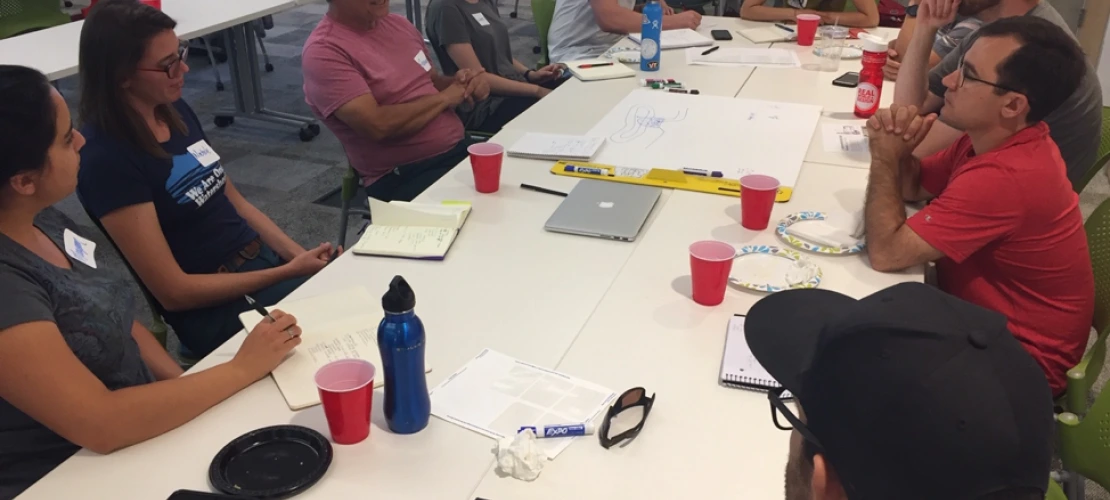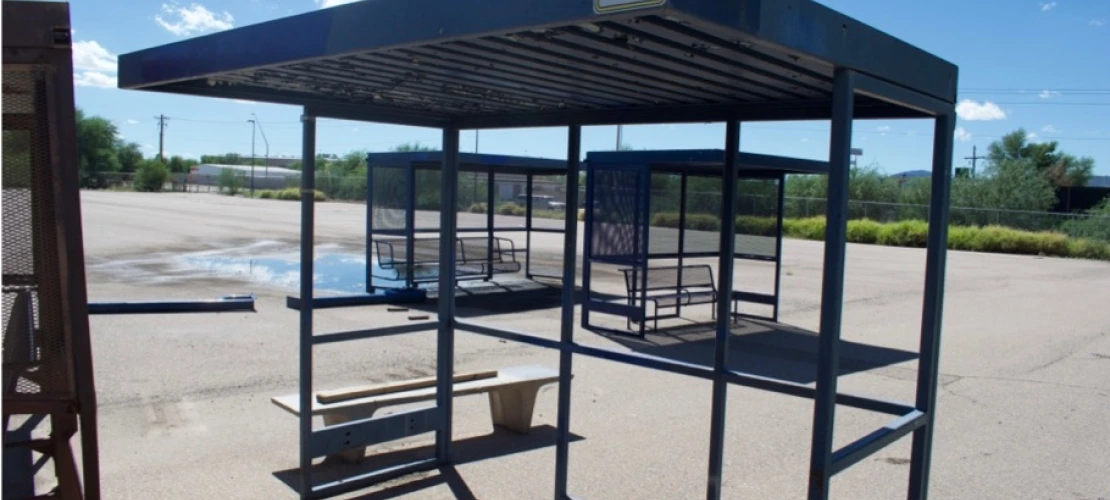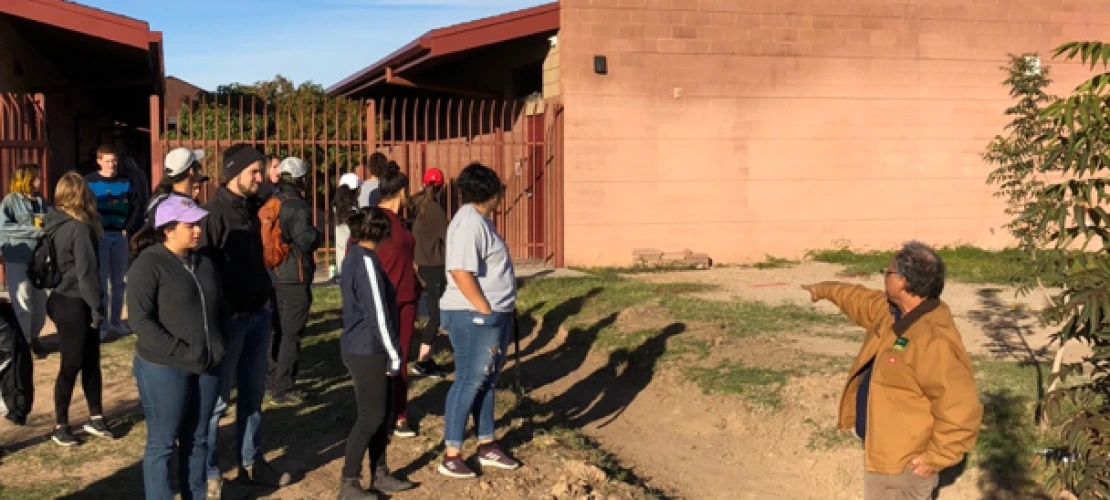By Alec Kelly-Jones
12/17/18 04:33:pm
Over the course of the past semester (fall 2018), I was fortunate to get the chance to intern with the University of Arizona’s Udall Center for Studies in Public Policy in implementing green infrastructure at Star Academic High School, made possible through funding from the University’s Green Fund. The experience has proved to be invaluable, as I was able to witness and participate in a project from the incipient ground-breaking phases and see it all the way through to completion. Over the last few months I have also gained valuable contacts from those within the Tucson Department of Transportation as well as members of Tucson’s Watershed Management Group. The experiences gained through participating in this internship have pushed me to grow in my role as a student, community leader, and as a professional which will surely serve as a benefit moving forward in my future as an ambassador of green practices.
After expressing initial interest in participating in this project, my desire to join was solidified during the informational kick-off meeting where the details of the project were introduced, and I was able to meet the majority of the people I would work with throughout the remainder of the project. During the presentation it became clear that the location of the school, situated in South Tucson, is underserved, especially in terms of green infrastructure, resulting in it being one if the hottest regions of the city. The University of Arizona provided funding in order to address this social injustice, with the goal of installing rain gardens as well as various trees and other native flora to increase the ratio of green infrastructure compared with the immense volume of grey infrastructure. Those working within the team selected an area of the project— choosing from either GI implementation, Community Outreach, Transportation, Art or Education— which to dedicate themselves and their expertise to. Initially, I chose the green infrastructure implementation team, who was tasked with logistically organizing the implementation of green infrastructure at Star High School (Figure 1). The team started by organizing a timeline in order to keep on track with project goals, specifically noting the day of excavation. When we went around the table asking for suggested tasks that had to be completed prior to that day, I learned of the excavation permits and marking of utilities that had to be completed prior to our excavation date.
As the semester progressed, I was asked by my supervisor, Dr. Adriana Zuniga, to help the teams working on Transportation and Community Engagement by joining in to aid them in their progress. The Transportation team was tasked with reaching out to the City of Tucson Department of Transportation to inquire about the logistics surrounding installing a bus stop shelter in front of the school. As I joined this team later into the project, I missed out on participating in the initial progress made to meet with the city’s officials to discuss the various requirements. Despite this, I became a vital part of the team as I was tasked with meeting Tom Fisher, our City of Tucson Department of Transportation contact point, to select a bus shelter for refurbishment. During this meeting Tom explained that by using a refurbished bus stop, we could skip the time-consuming process wherein new shelters must be certified by an engineer as being structurally sound. I collected photos of the various sizes of shelter represented in figure 2, before relaying them to the school’s principal Marsha Flores for selection. Through maintained communication, I was able to facilitate with Tom the installation of the concrete pad required to mount the shelter, and the shelter, free of charge. In order to gain a better sense of the use of the future bus stop, a ridership questionnaire was distributed amongst the students. The results of the questionnaire provided evidence of the need of a bus shelter that will serve the majority of the school community. Marsha sided with the smaller shelter for Star Academic High School for security reasons. However, because the City of Tucson has to bid this project out to its contractors, it has yet to be completed, though the implementation of the bus stop should hopefully be completed early next year.
In working on the Community Outreach aspect of the project, we were tasked with increasing both the school’s and the surrounding community’s awareness with the project. Hoping to insight community support through motivating students and community members to volunteer their time during the implementation day, we worked in collaboration with Tucson’s Tierra y Libertad Organization to get ideas on the best method of engagement. My fellow intern Maryam and I attended the school numerous times during the semester to meet with students and to raise awareness for the upcoming implementation day on November 17, 2018. We engaged with a small group of interested students to help us to design a poster and flyer represented in figure 3, that would be appropriate to motivate fellow high school students to come and help. After agreeing on the various elements and designing the flyer, we printed off copies which we had the teachers distribute at the end of the day as the students left campus. For the wider community, Maryam and I designed a separate leaflet which included both English and Spanish invitations, as the local population surrounding the school is primarily Spanish speaking. We then spent the day walking around the local homes personally inviting families to come and lend a helping hand to improve their community by planting trees, building benches and spreading mulch with our team.
The implementation day was a resounding success wherein many volunteers worked alongside our team from the University to see the project to the end, represented in figure 4. In order to have happy, nourished volunteers, I was tasked with acquiring breakfast snacks such as fruit, cereal bars, nuts, and cheese strings. With so many well-fed volunteers, we made light work of the various tasks which included digging holes for trees, spreading mulch, planting wild grasses, and building straw bale adobe benches. It was fantastic to see students and community members—many of which I had spoken to personally— lending their time to install green infrastructure and improve their community. Given that the shrubbery we installed was still quiet young, I revisited the site the following weekend to install temporary irrigation systems with a handful of volunteers. It was very insightful to learn about strategies for mitigating storm water run-off as well as how to plant and sustain a variety of plant life here in Tucson’s arid climate.
Participating in the implementation of green infrastructure at Tucson’s Star Academic High School was an extremely valuable and worthwhile experience. The level of community engagement we received on the implementation day provided me with a great sense of achievement and gave the project immense support. I really valued witnessing a project from its initial phases through its completion, and the experience I gained in maintaining professional ties of communication. Star Academic High School will now serve as a vanguard to the community and model the power of green infrastructure on Tucson’s south side.





